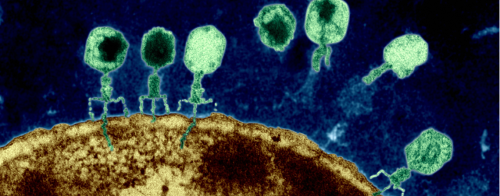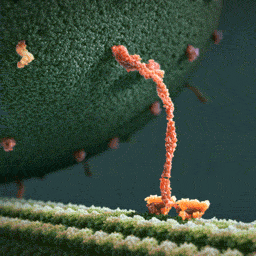The Honey Badger Of The Microbe World.

The honey badger of the microbe world.
More Posts from Bio100cia-blog and Others

Bacteriophages: Antibiotic Alternative or Just a Phase?
It is now clear that we are rapidly approaching a post-antibiotic era, and the need for an alternative is more vital than ever. The CDC estimates that approximately 2 million people are infected with antibiotic resistant bacteria each year, and of that 23 000 of them die as a result of the infection [1]. Our antibiotic pipeline is drying up and the development of new antibiotics is both slow and expensive, making antibiotics unappealing investments for pharmaceutical companies. Although alternatives to antibiotics are far from the market, the field is slowly expanding. Amongst the alternatives, bacteriophages (phages) are a potential candidate for both diagnostic and therapeutic medicine.
Quite simply, phages are viruses that infect bacteria. These are the most abundant biological entity on the planet and are thought to outnumber bacteria 10:1. Their sheer abundance has led to a vast diversity that has yet to be exploited by modern medicine. This is in part due to a number of problems with phages that haven’t made them ideal candidates for therapy. This article seeks to look at some of the problems with phages, and what steps are being taken to improve them for application in humans.
Rapid clearance from the host:
Delivery systems for phages have not been thoroughly assessed for systemic phage application. In other words we are still lacking a way of delivering a bacteriophage drug intravenously to ensure that phages have the maximal effect on the patient. Annoyingly, our immune systems are great at rapidly inactivating and removing them from our bodies [2], with animal studies showing that phage can be completely cleared within 24 hours [3]. Early work carried out in germ-free mice in the 70s showed that phages are passively collected in the mononuclear phagocyte system (MPS), where they remain viable until inactivated by immune cells [3].
There have been two solutions developed so far to amend this problem [2]. The first was developed in the late 90s by the National Institute of Health in the US, which involved the serial passage of phage through a living organism. It was hypothesised that some phage would have mutations in their coat proteins that would give them increased protection from the natural filtration systems in the body over wild type phage [3] and by selecting for these phage, you could gradually produce a population of long-circulating phage. When applied, these phage would have longer circulation times, and therefore a greater chance of colliding with their target bacteria. Animal studies have shown far better recovery of animals given long-circulating strains of virus over wild type, when presenting symptoms of otherwise fatal bacteraemia [4].
Figure 1. Diagram showing a few of the possible receptors for Salmonella sp. phage [5]
Additionally, to prevent degradation or inactivation of phages, polymers can be added to the coatings of phages [1]. The polymer polyethylene glycol (PEG) has been shown to increase systematic circulation and decrease T-helper cell activation in response to phage. It is likely that a combination of these two methods may improve delivery strategies in the future of phage therapeutics.
Altering host range and preventing resistance:
Unlike antibiotics, phages have incredibly refined, narrow host-ranges. This property is in reality a double edged sword: in many cases, phages are only able to target a few strains of a single species, whereas antibiotics relentlessly target multiple branches of the bacterial phylogenetic tree. Antibiotic treatment can lead to disruption of the host’s own microbiota which can permit the colonisation of nastier and less cooperative microorganisms.
In contrast, phages can target their host whilst leaving the surrounding organisms in relative peace. When a patient presents symptoms of infection, the particular species or strain causing the infection would be unknown. Identifying the culprit before selecting the right phage would take time a patient may not have.
Receptors on the bacterial cell surface are what determine which phage are able to bind to the cell. A wide variety of receptors are used by phage, but many still remain a mystery. To curtail these issues and ensure that as many receptors can be targeted for a particular bacterium, phage cocktails are used [6]. These are mixtures containing a number of different phage strains. In theory, the cocktail should be designed so that the phages together should be able to target all the known clinically relevant strains of a particular species of bacteria.
Creating phage cocktails from natural sources can be laborious [7], however viral DNA provides a platform for genetically engineering phages with desired properties. Improving phage cocktails with modified phages expressing structures that could target a wide variety of receptors on a bacterial cell could ensure that a cocktail could target the maximum number of strains, whilst reducing the selection pressure on a sole receptor. Resistance to the phage cocktail would then also be avoided.
Much of this work looks at genetically engineering phage tail fibres [7, 8]. These ‘spider-leg’ like components regulate the initial binding step between a phage and a target cell. It has been shown by Mahichi et al, 2009 and Ando et al, 2015 that switching tail fibres between phages with different host ranges can confer host-range specificity from one phage to another. Hopefully, modular engineering of phages will push phage technology forwards, offering new strategies for developing phages for therapeutic purposes.
Figure 2. Diagram showing how the modular shuffling of tail fibres between viral strains can confer host range of parental strain [7].
Preventing the release of cellular toxins
A major health risk of phage, is that like β-lactam antibiotics, they interfere with the bacterial cell wall integrity and ultimately lead to cell lysis. Lysing cells prevents further replication, but also releases all the cell’s content. This may include but not be limited to superantigens and lipopolysaccharides (LPS) [2]. These toxins will trigger the inflammatory response, and in extreme cases cause organ failure and death.
Phages have a simple dual-lysis system consisting of a holin and endolysin. The holin is a pore-forming membrane protein that creates an exit from the cytoplasm for the endolysin. The endolysin is then able to attack the peptidoglycan of the bacterial cell wall, resulting in its rupture. To generate phage incapable of lysing a cell, the dual lysis system simply needs to be inactivated.
To restore killing power to the phage in the absense of the dual lysis system, a bacterial toxin needs to be incorporated into the phage genome. Hagens et al, 2004 has shown that by engineering the filamentous phage M13 to encode a non-native restriction enzyme, antimicrobial activity can be restored through the generation of double stranded breaks in chromosomal DNA. Upon infecting Psuedomonas aeruginosa with this phage, there was a 99% drop in viable cell counts over the time course [9]. Other research has looked into other uses for the non-lytic killing of bacteria, including proteins that interfere with regulatory systems and other bacterial toxins.
Conclusions:
Phage therapy has shown promise in recent years as being a good candidate for either working in synergy with or replacing antibiotics. The appalling lack of human based clinical trials haven’t helped to expose their potential for human use. Although this is the case, a significant amount of work has been done on improving phage therapy in preparation for further studies with human application. The past 15 years have seen an improved outcome for this technology as obstacles with phages are gradually manoeuvred by intelligent reengineering. With hindsight we have now acquired through our experiences with antibiotics, hopefully we will not make the same mistakes with phages as we have done with antibiotics.
1. CDC (2013) Antibiotic resistance threats. US Dep Heal Hum Serv 22–50 2. Lu TK, Koeris MS (2011) The next generation of bacteriophage therapy. Curr Opin Microbiol 14:524–531 3. Carlton RM (1999) Phage therapy: past history and future prospects. Arch Immunol Ther Exp (Warsz) 47:267–274 4. Merril CR, Biswas B, Carlton R, Jensen NC, Creed GJ, Zullo S, Adhya S (1996) Long-circulating bacteriophage as antibacterial agents. Proc Natl Acad Sci U S A 93:3188–3192 5. Chaturongakul S, Ounjai P (2014) Phage host interplay: examples from tailed phages and Gram-negative bacterial pathogens. Front Microbiol 5:1–8 6. Moradpour Z, Ghasemian A (2011) Modified phages: Novel antimicrobial agents to combat infectious diseases. Biotechnol Adv 29:732–738 7. Ando H, Lemire S, Pires DP, Lu TK (2015) Engineering Modular Viral Scaffolds for Targeted Bacterial Population Editing. Cell Syst 1:187–196 8. Mahichi F, Synnott AJ, Yamamichi K, Osada T, Tanji Y (2009) Site-specific recombination of T2 phage using IP008 long tail fiber genes provides a targeted method for expanding host range while retaining lytic activity. FEMS Microbiol Lett 295:211–217 9. Hagens S, Habel A, Ahsen U Von, Gabain A Von (2004) Therapy of Experimental Pseudomonas Infections with a Nonreplicating Genetically Modified Phage Therapy of Experimental Pseudomonas Infections with a Nonreplicating Genetically Modified Phage. Antimicrob Agents Chemother 46:3817–3822


The downside to making your own food…you’re probably going to get eaten by a heterotroph.

The building blocks of all life; nucleotides, DNA, and chromosomes




Mitosis, Neurons, and the DNA replication complex.

Terrifying. 🎃


A tardigrade (waterbear) hatching.
Tardigrades reproduce sexually and females lay eggs. She’ll actually shed her skin first and then lay her eggs inside of it. The babies then hatch from their eggs and then have to crawl out of the skin husk. Fun fact: tardigrades are born with the same number of cells as their adult counterparts - their cells just get bigger as they age.

A bacterium living on the diatom of and amphipod
(Reddit)
Zoooooooooooom

Kinesin (a motor protein) pulling some kind of vesicle along some kind of cytoskeletal filament.
-
 ebbpup liked this · 2 years ago
ebbpup liked this · 2 years ago -
 narupity liked this · 3 years ago
narupity liked this · 3 years ago -
 digigal-transbian liked this · 4 years ago
digigal-transbian liked this · 4 years ago -
 corv1kn1ght liked this · 4 years ago
corv1kn1ght liked this · 4 years ago -
 nonamecody reblogged this · 4 years ago
nonamecody reblogged this · 4 years ago -
 confofahatmin liked this · 4 years ago
confofahatmin liked this · 4 years ago